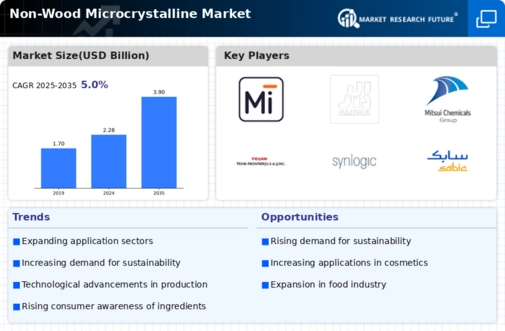Market Charts and Visual Data
Growing Demand for Sustainable Products
The Global Non-Wood Microcrystalline Market Industry experiences a notable surge in demand for sustainable and eco-friendly products. As consumers become increasingly aware of environmental issues, industries are shifting towards non-wood alternatives that offer similar properties without depleting forest resources. This trend is particularly evident in sectors such as cosmetics and pharmaceuticals, where microcrystalline cellulose derived from non-wood sources is favored for its biodegradability. The market is projected to reach 2.28 USD Billion in 2024, reflecting a growing preference for sustainable materials in product formulations.
Technological Advancements in Production
Technological innovations play a pivotal role in enhancing the efficiency of the Global Non-Wood Microcrystalline Market Industry. Advances in extraction and processing techniques enable manufacturers to produce high-quality microcrystalline cellulose from non-wood sources at lower costs. These improvements not only increase yield but also reduce waste, making the production process more sustainable. As a result, companies are likely to invest in these technologies to remain competitive. The anticipated growth of the market to 3.9 USD Billion by 2035 suggests that these advancements will significantly contribute to the industry's expansion.
Regulatory Support for Non-Wood Materials
Regulatory frameworks increasingly favor the use of non-wood materials, thereby bolstering the Global Non-Wood Microcrystalline Market Industry. Governments worldwide are implementing policies that promote the use of sustainable resources, which aligns with global sustainability goals. For instance, regulations that limit the use of wood-based products in certain applications encourage manufacturers to explore non-wood alternatives. This regulatory support not only drives innovation but also enhances market accessibility for non-wood microcrystalline products, potentially leading to a compound annual growth rate of 4.99% from 2025 to 2035.
Expanding Use in Pharmaceutical Applications
The pharmaceutical industry is witnessing an expanding use of non-wood microcrystalline cellulose, which is recognized for its excellent binding and disintegration properties. This trend is particularly relevant in the formulation of tablets and capsules, where consistency and quality are paramount. The Global Non-Wood Microcrystalline Market Industry benefits from this growing application, as manufacturers seek reliable excipients that meet stringent regulatory standards. The increasing focus on patient-centric formulations is likely to drive demand further, contributing to the anticipated growth of the market to 3.9 USD Billion by 2035.
Rising Applications in Food and Beverage Industry
The food and beverage sector is increasingly adopting non-wood microcrystalline cellulose as a functional ingredient, thereby driving growth in the Global Non-Wood Microcrystalline Market Industry. This ingredient serves various purposes, including as a thickening agent, stabilizer, and texturizer, which enhances product quality and consumer appeal. As health-conscious consumers seek cleaner labels, the demand for non-wood microcrystalline cellulose is likely to rise. This trend is expected to contribute to the market's growth trajectory, with projections indicating a significant increase in market size over the coming years.



















